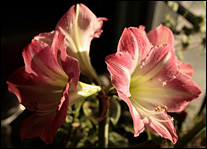Roses Throughout History
The rose has a long history in gardens and in literature. There are a number of expressions that use the rose as a metaphor. "A bed of roses" refers to the Sybarites who were able to enjoy the luxury of sleeping on mattresses filled with rose petals. The common Latin phrase sub rosa (under the rose), meaning in strict confidence, refers to the use of the rose as a symbol of secrecy. Roses were carved in the ceilings of Roman dining rooms and over 16th-century church confessionals, in both cases to remind those under it (sub rosa) that anything said there was not for publication.
- Created on .


 In a short growing season, many plant lovers move their much-loved tropical specimens inside for the winter, to bring some living greenery to the holiday season. One of the winter’s favorite holiday plants is the Amaryllis, or Hippeastrum.
Almost all plants sold as Amaryllis in stores and garden centers are actually Hippeastrum. Hippeastrum is very similar to Amaryllis; in fact, they are sister plants. Both are in the family Amaryllidaceae, and most plant owners would not notice the difference. Hippeastrum is easier to grow indoors and flowers better in those conditions than Amaryllis. Most likely, the bulb you bought that was marked "Amaryllis" is really Hippeastrum
Hippeastrum bulbs have a long history of indoor use, dating back to the 18th century. In warmer climates they can be grown outdoors year-round, but in cooler areas they must be brought inside to avoid freezing. Hippeastrum should be brought in when night-time temperatures are below 50°F.
In a short growing season, many plant lovers move their much-loved tropical specimens inside for the winter, to bring some living greenery to the holiday season. One of the winter’s favorite holiday plants is the Amaryllis, or Hippeastrum.
Almost all plants sold as Amaryllis in stores and garden centers are actually Hippeastrum. Hippeastrum is very similar to Amaryllis; in fact, they are sister plants. Both are in the family Amaryllidaceae, and most plant owners would not notice the difference. Hippeastrum is easier to grow indoors and flowers better in those conditions than Amaryllis. Most likely, the bulb you bought that was marked "Amaryllis" is really Hippeastrum
Hippeastrum bulbs have a long history of indoor use, dating back to the 18th century. In warmer climates they can be grown outdoors year-round, but in cooler areas they must be brought inside to avoid freezing. Hippeastrum should be brought in when night-time temperatures are below 50°F.